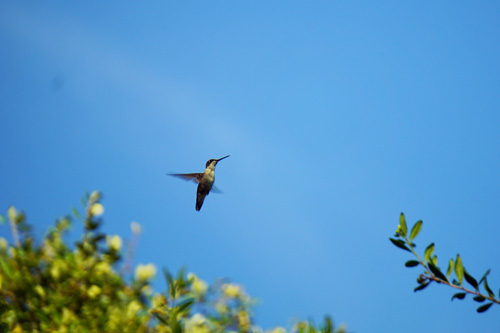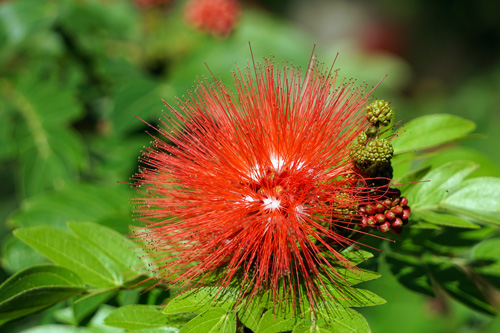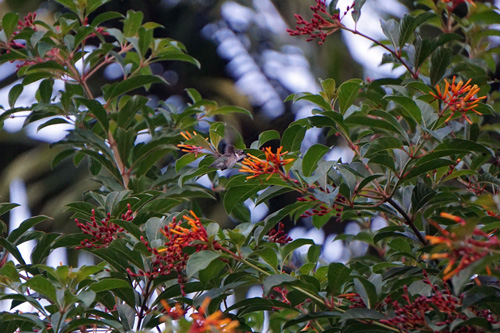Of Interest in the Garden: Glimpsing a Gem in the Garden

By Arielle Simon
Winter is a wonderful season in tropical South Florida. While the plants and animals in the majority of the northern hemisphere are dormant or hibernating at this time of year, South Florida is rich with life and color. Follow any path in the Garden and you will see lush greens, vibrant reds, purples, pinks and yellows. Look up at the flowering trees and vines, and look around at the flowering shrubs. For most of us, flowers are attractive because they are beautiful, colorful, fragrant or unusual. But for wildlife, flowers are food. Pollinators such as butterflies and moths, bees, and hummingbirds rely on the pollen and nectar from various flowers to sustain them. At this time of year, a keen eye or attuned ear can glimpse a hummingbird visiting some of the bright, nectar-rich flowers in the Garden.
Hummingbirds, which are found exclusively in the Americas and surrounding islands, are capable of remarkable maneuverability—they can fly vertically, backwards, side-to-side, and even hover stationary in midair scoping out their surroundings or sipping nectar from a flower. The rapid beating of their wings sounds like a small helicopter or giant mosquito, and they chirp a distinguishable high pitched song. So, you’re likely to hear a hummingbird before you see it. The birds are only a few inches tall at most—about the size of a fun-size candy bar, and move rapidly like a blur across the landscape. When you do see a hummingbird, you may be surprised at first if you don’t see their gem-colored plumage, but just watch a moment and you’ll see the brilliant colors glimmer at just the right angle.
In South Florida, the most common hummingbird is the Ruby-Throated Hummingbird (Archilochus colubris). Other hummingbirds passing through South Florida include Rufous (Selasphorus rufus), Black-Chinned (Archilochus alexandri), and Buff-Bellied (Amazilia yucatanensis). Hummingbirds are omnivorous, eating insects as well as nectar. They have extremely high metabolism, so they eat frequently throughout the day. There are several plants in bloom in the Garden whose nectar-rich flowers are particularly inviting to hummingbirds.

Ruby-Throated Hummingbird (Archilochus colubris)
Calliandra haematocephala, red powder-puff, has long red stamens that protrude enticingly from the clusters of tiny flowers. This ornamental shrub adorns the patio outside of the Arts Center (plot 41). The dwarf form, Calliandra haematocephala ‘Nana’, can be found in the South Florida Butterfly Garden (plot 19b) and alongside the brick path leading to and from the Visitor Center (plot 50).

Calliandra haematocephala, red powder-puff
Hamelia patens, firebush, is a native shrub. The clusters of red-orange tubular flowers are frequented by butterflies, especially Florida’s state butterfly the Zebra Longwing, and hummingbirds. The large bush outside the Visitor Center (plot 17) and the firebush in plots 30, 35, and the South Florida Butterfly Garden (plot 19b), are surefire places to spot a hummingbird.

Hamelia patens, firebush
Holmskioldia sanguinea, Chinese hat plant, is one of the best hummingbird attractors. The sprawling shrub produces groupings of orange-red saucer-like flowers with a narrow, tubular center all along its many arching branches. You can’t miss it if you’re walking by plot 3a adjacent to the Vine Pergola.
Holmskioldia sanguinea, Chinese hat plant
Pavonia bahamensis, Bahama swamp-bush, is in the hibiscus family (Malvaceae). The rolled up green, hibiscus-like flowers are full of nectar and the plant is always in bloom. You’ll find it in a few places in the Garden—plots 26 and 35, and in the lowlands at the edge of Center Lake in plot 166.
Other popular hummingbird plants currently in bloom:
Clerodendrum thomsoniae ‘Delectum’, magenta bleeding heart vine, is along the wall of the Vine Pergola.
Combretum rotundifolium, monkey’s brush, is a vining shrub in front of the Vine Pergola (plot 7).
Justicia brandegeeana, shrimp plant, is located in the South Florida Butterfly Garden (plot 19b).
Odontonema species, firespike, is in plots 19a, 32b, 50, and 57a.
Pogonopis speciosus, chorcha de gallo, is located in plot 24.
